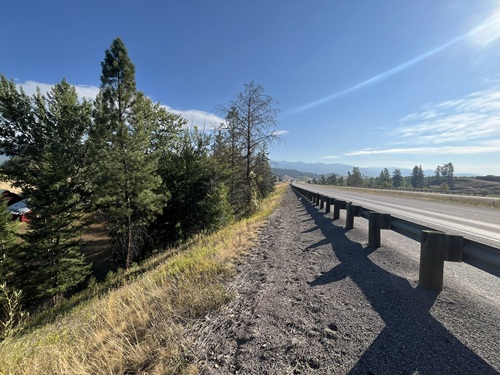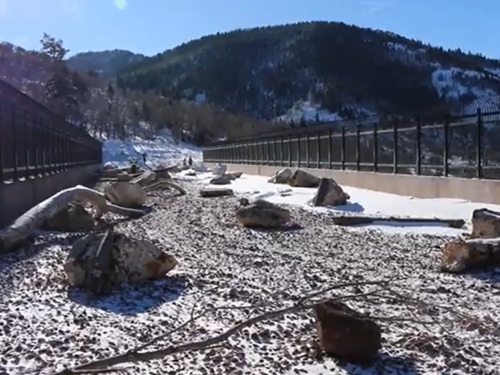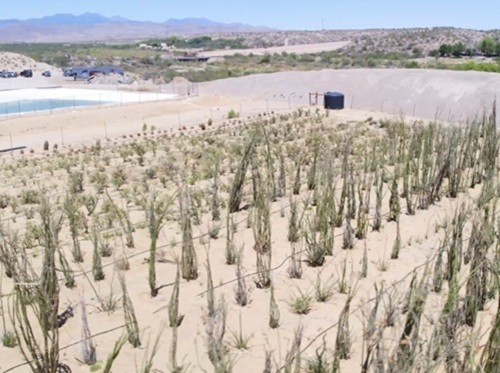When the Utah Department of Transportation built a wildlife bridge over the new Interstate 15 in 1975 near Beaver, it literally wasn’t front-page news. It merited only a brief mention on page five of the local paper, which called it “a project to aid reduction of deer highway mortality.”
[Above photo by Utah DOT]
Mirroring’s Utah’s reputation as a state of humble, hard-working pioneers (the state motto is “industry” after all), Utah DOT still tends to bypass the spotlight while quietly going about its work. It took 50 years for that I-15 overpass near Beaver to be widely recognized and celebrated as the first wildlife crossing over a highway in the United States.
Such projects have become almost commonplace in Utah; home to a variety of big mammals, reptiles, amphibians, birds – nearly everything from antelope to weasels. Today, it is estimated that Utah DOT has built more than 60 crossings and installed hundreds of miles of fencing across the state to keep wildlife and motor vehicles separated.
[The video below provides an overview of a wildlife crossing in Parley’s Canyon over I-80 opened by Utah DOT in 2018.]
“This is one of the most passionate issues we have. It really is a focus of the entire department,” said John Gleason, Utah DOT’s director of public relations. “You think about the destruction you can have if a vehicle hits a moose. These are the things we want to prevent.”
Preventing wildlife-vehicle collisions in Utah, however, isn’t simple. Long stretches of highways bisect arid deserts, mountain ranges, and dense pine forests in a state with more land mass than New England but less than a quarter of that region’s human population.
Recently, Utah DOT received a $9.6 million federal grant for wildlife safety improvements along US 40, which will pay for 23 miles of fencing and four wildlife underpasses. That news came weeks after the department installed three miles of fencing to funnel wildlife to an undercrossing near the I-80 and I-84 interchange, about 30 miles east of Great Salt Lake.
In southern Utah, the department will soon add three more wildlife underpasses and several miles of fencing along US 89, which crosses a natural migration route for the Paunsaugunt Plateau mule deer herd. In 2013, Utah DOT built seven wildlife underpasses along the route, and studies show thousands of animals have used them.
Not all the crossings are for big moose and deer, though. The department has built small culvert underpasses for the Mojave Desert tortoise, an endangered species only found in Utah, California, Arizona, and Nevada. Utah DOT also is planning tunnel-style crossings for Utah prairie dogs in the southern half of the state.
The fencing-and-crossing projects are successful because animals learn where the safe passages are, Utah DOT Natural Resource Manager Matt Howard said.
“Over time, they don’t even need the fencing. Once a few generations have passed, they go straight to the crossing,” he said. “We joke that it’s a lot easier to change wildlife behavior than human behavior.”
Utah DOT relies on wildlife behavior experts at the Utah Division of Wildlife Resources (UDWR) to help plan the projects. In fact, the Utah DOT-UDWR relationship goes far beyond the usual inter-agency cooperative agreements that are common on so many government projects.
“One of the keys to us having a successful program is our relationship with the wildlife agency,” Howard said. “It really started out as friendships, people who hunt and fish together. We never go more than three months without talking. We don’t have a lot of bureaucracy getting in the way.”
While Utah DOT has the engineering and construction know-how on these projects, UDWR understands animal migration, feeding, and mating patterns. Together, the agencies share expertise and research to plan the optimal types of crossing in the best locations.
“UDWR’s partnership with Utah DOT is critical in maintaining wildlife connectivity across the state by implementing projects that allow species to move freely across roads, which can be barriers to migration,” UDWR Migration Initiative Coordinator Makeda Hanson said. “Coordination and data-sharing between the two agencies help us work together to find solutions that improve both wildlife and human safety.”
For example, UDWR and Utah DOT wanted more data to plan the kinds of safety projects to build and exactly where to build them. One solution was The Utah Roadkill Reporter; a smartphone application introduced in 2022 that gets the public involved in reporting wildlife collisions.
Anyone can use the app to report where an animal was hit and killed by a motor vehicle in Utah. If it’s safe, a vehicle occupant can take a picture of the carcass and include it in the report, which alerts a crew to remove the carcass.
But the real payoff for Utah DOT and UDWR is that each roadkill report provides a wealth of information. The app prompts users to identify what kind of animal was killed, how old it appeared, and whether it was male or female. The agencies use that information to pinpoint when and where specific animals want to cross the road, which helps in project planning.
“The carcass pickups reported to the app have historically been the most-used data point to guide wildlife projects,” Howard said. “We also take into account collar data and law enforcement crash data.”
Citizens have filed almost 10,000 roadkill reports since the app was introduced in 2022.
While Utah DOT still spends the bulk of its budget on traditional road and bridge projects, Gleason said state residents are supportive of the wildlife safety projects. “With all the great work we’ve done in this area, the public wants more of these wildlife crossings, they want more wildlife fencing,” he said. “They want us to take the time to study the migration patterns and make sure, if we’re going to invest public dollars in a project, it makes sense to put a passing or fencing here. It’s all about making the best use of public funds.”
 Wildlife and Ecosystems
Wildlife and Ecosystems



